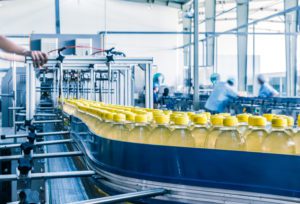3 Biggest Challenges Food Manufacturers Face
Food manufacturers are used to fluctuations in supply and demand, due to factors such as seasonality, droughts, consumer trends and promotions – but, this year is a little different. Some manufacturers are faced with surge in demand based on changing consumer behavior, pushing plants to operate at max capacity. Other manufacturers have had to downsize operations temporarily due to employee illness and fears due to COVID-19. Companies are still struggling to meet the immediate near-term challenge of how to remain open and operational, prioritize safety, and overcome supply chain challenges.
According to a recent survey by the National Association of Manufacturers, 67% of all manufacturers have continued to run at full capacity throughout the pandemic, 76% have had to simultaneously implement flexible work options, and 67% had to re-engineer their processes to reflect COVID-19 safety protocols.
At the same time, companies forced to determine what the new normal looks like and predicting changes in demand has left many in the food and beverage industry scratching their heads. COVID-19 has transformed how consumers shop and how retailers sell products. As a result, food manufacturers and retailers must adapt and build new capabilities to change how they operate.
3 Challenges Food Manufacturers Face
There are three challenges food manufacturers face because of the global pandemic. The first being, how do you keep your employees safe? According to a recent study by Food Industry Executive, more than 40% of food processors and one in five suppliers said employees are afraid to come to work amid the pandemic. The second is, how can you be more productive and increase production capacity, or be more effective in the way you are producing goods? And finally, how can manufacturers adapt to changing consumer buying preferences?
1. Keeping Employees Safe
The pandemic has created much uncertainty around the world, but particularly in food manufacturing. Through August, COVID-19 cases and overall fears have caused nearly 60 U.S. factories to shut down or reduce production. Thousands of workers in meatpacking plants alone have been infected with COVID-19. Employees are afraid. Manufacturers have been forced to refocus priorities. And, businesses that remain open must ensure it is safe for workers to go into the factories. Whether that is increased personal protective equipment (PPE) available, or enhanced cleaning procedures – everyone is adjusting accordingly. Reducing the potential risk of a viral spread on the plant floor is not only vital for worker health and well-being, but also critical for business continuity – since it is human workers who are crucial to keeping manufacturing plants running.
2. Being More Productive and Increasing Production Capacity
In terms of demand, the real challenge comes with navigating consumer behavior. As some food manufacturers see a surge in demand, they must keep up with capacity and find ways to be more efficient to either offset weaker margins because of reduced demand or to ramp up production to meet higher demand. On a positive note, survey respondents were optimistic about the future; 54% said they think the business will come back stronger after the pandemic.
3. Meeting Changing Consumer Buying Preferences
Lastly, there has been a noticeable shift in consumer buying habits. At the beginning of the pandemic, there was a surge in sales of non-perishable, frozen and canned foods. Consumers were stock-piling food and other essential household items, due to uncertainty around stock and store closures. On top of that, people have been driven to purchase more groceries as a result of many individuals working from home.
For example, with increased social distancing restrictions and a ban on large gatherings, beer consumption at concerts or sporting events has been put to a halt. Consumption has not decreased, but the profit from breweries is under pressure, because the margin on beer consumed at an event is much higher versus purchasing beer at a supermarket. Without large gatherings, like sporting events or concerts, people are paying around $5 for a beer at the supermarket, as opposed to $15 or $20 at an event.
Changes in consumer behavior as a result of COVID-19 have made it more difficult for food manufacturers to gauge demand accurately. Past buying behavior is no longer a predictor of future demand.
While addressing these factors in helping food manufacturers weather the storm, technology will play a pivotal role in that journey.
Enable Leaner Manufacturing With Connected Worker® by Parsable
A spoiled food batch – depending on when it is caught – can lead to varying degrees of waste. If a spoiled batch leaves the manufacturing plant and goes to the warehouse, or even worse if it makes its way to store shelves – results in huge financial losses and is damaging to a brand’s reputation. How can you react faster to waste and catch these issues early on?
As you can imagine, in food manufacturing there is an incredible amount of food and resource waste that occurs. Much of that waste comes from human error in the manufacturing process, where workers are not trained correctly, or they did not realize what they were doing was wrong. The guidance that digital standard operating procedures (SOPs) provide, ensures workers are properly trained and understand how to execute a procedure, job steps are followed consistently and there is less probability of making a mistake due to involuntary human error.
Connected Worker can turn static paper-based industrial work processes into dynamic, digital and interactive procedures. It is a simple and easy to use solution to help your frontline workers and internal experts capture, digitize and author SOPs – empowering frontline workers in food manufacturing plants. This is a key step to ensure efficiency and to be able to meet changes in production. It also helps guide workers on new or unfamiliar processes, with step-by-step instructions built directly into the app.
Relying on traditional paper-based procedures and capturing data on paper can result in pencil-whipping, human errors in data recorded and delayed response times. For example, if you find a defect on your production line, that gets captured on paper, gets input into an Excel dashboard, gets sent to the quality person, who then alerts the production manager. Not only is there room for error in the data being captured, but there are a lot of hand-offs and time wasted. With a digital platform, you are able to capture data throughout every step of the manufacturing process and shorten the response time. Efficiency comes from the granularity of data and the ability to receive near real-time updates in analytics dashboards – to identify potential issues or trends in processes and to notify the appropriate team member immediately within the app.
Connected Worker empowers those on the industry front lines with the tools and the peace of mind to get their jobs done as safely and efficiently as possible. Digital tools are no longer a nice to have, but a must have, empowering your teams to be successful in these changing world environments.





